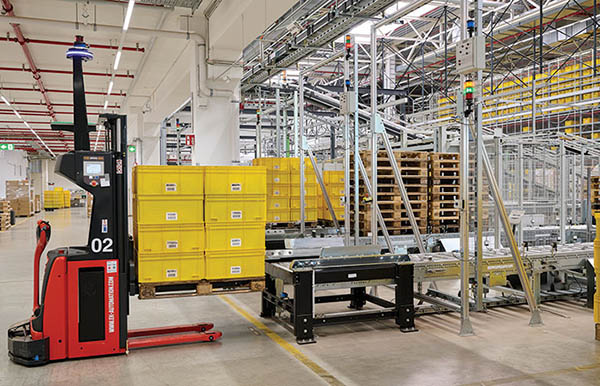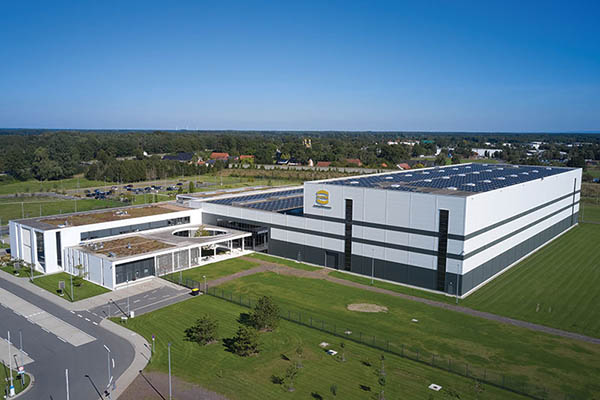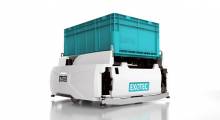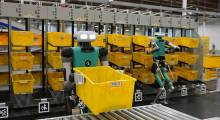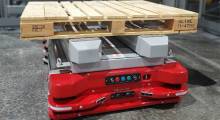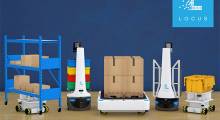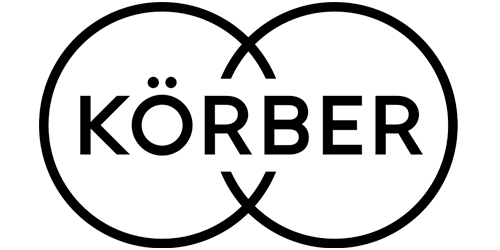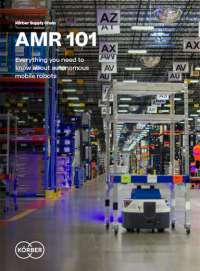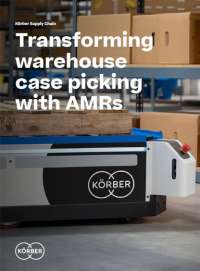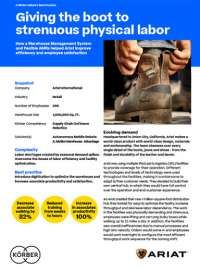How do you design a warehouse to support sales of €1 billion ($1.16 billion U.S.) per year? That warehouse will have to support multiple business channels, including regional business-to-business customers as well as a global distribution network. That was the question put to the logistics team at HARTING Technology Group in 2012.
“After 20 years, the software running our existing European distribution center was unstable, and we needed more space and throughput capacity,” recalled Achim Meyer, managing director of logistics at HARTING Technology Group. The German company is the logistics arm of HARTING, one of the world’s largest suppliers of products that enable industrial automation.
To provide an answer, the logistics team started with that question and then worked backwards. How much storage capacity might be needed to support that level of sales? How many new items will be introduced each year? And how many line items, parcels and weight would have to move each day to achieve that level of sales?
Harting finds partners
HARTING worked with Körber AG, a global systems integrator, as well as the Institute for Materials and Logistics to design and build the 600,000+ sq. ft. distribution center in Espelkamp, Germany.
The facility, which went live in September 2019, is a showcase for warehouse and distribution center automation. It features technologies including the following:
- Automatic guided vehicles (AGVs) for non-value-added travel
- Automatic depalletizing, palletizing, and shrink-wrapping
- Pallet- and carton-handling, crane-based automated storage and retrieval systems (ASRS)
- Vertical lift modules (VLM) for small parts storage
- A shuttle system for buffer storage of order totes
- Pallet conveyor with transfer cars
- RFID for pallet tracking and quality control
In addition, HARTING is using SAP’s Extended Warehouse Management (EWM) product as its control system.
“We believe the Espelkamp facility is one of the first warehouses in Germany to run under EWM,” Meyer said. “It was a learning curve for us, but SAP is our IT backbone, and EWM manages every storage location and movement in the warehouse.”
After nearly two years of operation, Meyer said the facility is meeting its storage and throughput goals. But perhaps most important is its ability to adapt to customer requirements without deviating from standard processes.
“If a customer calls with an urgent order 10 minutes before a truck is ready to leave the building, I can override any existing orders in the system, and pick and pack the order before the truck leaves the building,” Meyer said. “The flexibility we now have is key.”
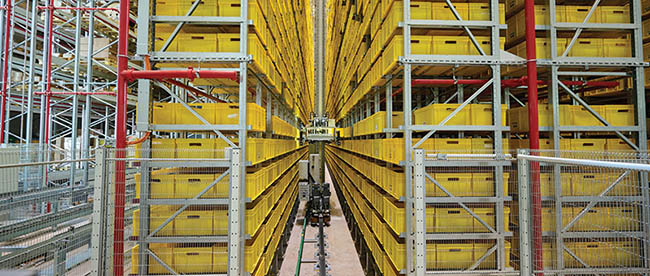
Determining requirements
With global headquarters in Espelkamp, Germany, the HARTING Technology Group describes itself as “a leading global supplier of industrial connection technology for the three lifelines of data, signal, and power.”
The company was founded in September 1945 by Wilhelm and Marie Harting to make household and consumer products, such as energy-saving lamps, hot plates, and waffle irons. As it grew, Harting recognized the need for new technical products to serve growing industries. The company developed an industrialized connector that was robust, easy to handle, and applicable for a variety of purposes.
Today, the HARTING Technology Group is still managed by the Harting family and was recently recognized as one of Germany’s most innovative companies. The company operates 14 production sites and 15 distribution centers around the world.
The backbone of the distribution network is three central DCs located in Espelkamp; Shanghai, the company’s second-largest market; and Elgin, Ill., which serves the U.S., Canada, and Mexico.
Additional facilities are located near sales offices or production facilities in South America, Russia, Japan, and Hong Kong, to name a few. The European DC serves many of HARTING’s European customers and replenishes other warehouses.
Prior to building the new facility, HARTING operated from a 30-year-old facility that was no longer able to keep pace with the company’s growth or customer requirements.
“We were out of space and couldn’t get the throughput we needed,” said Meyer. “Our aging automated systems required more maintenance, and our 20-year-old warehouse management system [WMS] was no longer stable.”
Just as important, the 30-year-old systems were not designed for item-handling, smaller parcels or the rapid turnaround and delivery times associated with the increase in e-commerce, including electronic data interchange (EDI).
.jpg)
To design the new European DC, Meyer and his team identified a half-dozen goals that drove their requirements.
Fast and flexible: HARTING wanted systems that could react based on the workload at any given time.
“We wanted to have workload on demand,” Meyer recalled. “If I see an order peak, we have simplified the picking process so that I can move people from another part of the facility to support picking.”
Meet customer requirements within existing processes: Increasingly, customers want orders customized to their requirements.
“In the past, we avoided orders that required special pallets, special labels or kitting,” said Meyer. “Now, we’re able to enter a customer’s requirements into the system, and it just becomes part of the automated process. Instead of avoiding customization, it has become a competitive advantage.”
Use automation and HARTING technologies wherever possible: As a company whose products enable connectivity, HARTING believed it was important to use automation wherever it could deliver value, and to use HARTING’s products where feasible. As an example, RFID—a HARTING technology—is used to automatically track the location of pallets in the facility and as a quality-control check during truck loading.
“Customers visit us almost every day to see how we handle their products,” Meyer said. “I can show them how we use automation, and I can show them that every meter of automation is using HARTING technologies.”
Make it sustainable: Sustainability is a key component of HARTING’s 2030 strategy. “All of our energy is renewable,” noted Meyer. He added that the building uses geothermal and bio-gas technologies for heating and cooling.
Regenerative systems, such as regenerative braking on storage and retrieval cranes, put energy back into the system and an energy management system ensures the facility optimizes the energy it does use.
Make it ergonomic: “The heart of any warehouse is still people,” Meyer said. “We wanted the most ergonomic workstations as possible.”
For example, workstations were designed with a team that included engineers, specialists in ergonomics, and associates. Mockups were put together using cardboard and tape and then refined after being put to the test. The teams relied on Kaizen principles to determine the location of every box, pen, and tool at a picking or packing station.
Make it transferable: HARTING wanted systems and processes that could be implemented in its other warehouses once they were doing the same volume as Espelkamp.
During this early stage, the logistics team worked with the Fraunhofer Institute for Material Flow and Logistics IML in Dortmund to document the requirements for a new facility.
.jpg)
Ideas competition
In 2013, HARTING sent a 300-page requirements document to 10 companies it believed might be interested in creating the warehouse. One of the criteria was that there be one general contractor for the building and one integrator for the systems in the facility, including the WMS.
While awaiting proposals, Meyer and his team visited more than 100 warehouses throughout Europe.
“Like a honeybee, we collected honey,” he said. “We looked at how other companies used technology to support their processes in the best possible ways. About 80% of what I saw, I wouldn’t do, but we learned so much.”
Among the technologies he did want to implement was RFID. One of his ideas for an application came from a paper company that embedded RFID tags in the concrete floor at each of its 11,000 storage locations. When a pallet was put away into storage, RFID was used to marry the pallet to the storage location.
Another idea came from a grocer that was shipping out as many as 1,000 trucks a day. When an associate rolled a trolley equipped with RFID tags through a portal at a dock, he was alerted that he was at the right location. A 2% error rate was reduced to nearly zero.
HARTING combined the two processes in the new facility. Lift trucks equipped with RFID readers automatically read a tag on pallets as well as RFID tags at storage locations—in the shipping area, tags are embedded in the concrete.
Meanwhile, an overhead reader at each dock ensures the right load goes on the right truck.
Five of the 10 companies were invited to deliver a presentation as part of the ideas competition. From there, the list was narrowed to three integrators that were asked to work with the Fraunhofer Institute to refine their designs and quotes.
In 2014, when the HARTING team was ready to proceed, they were asked by management to reduce the anticipated cost by 25%.
Over the next two years, Meyer’s team worked with the Fraunhofer Institute and the three systems integrators to streamline the design, one screen at a time. At the end of that period, a building contractor was in place, and Koerber was selected as the integrator. They broke ground in March 2017.
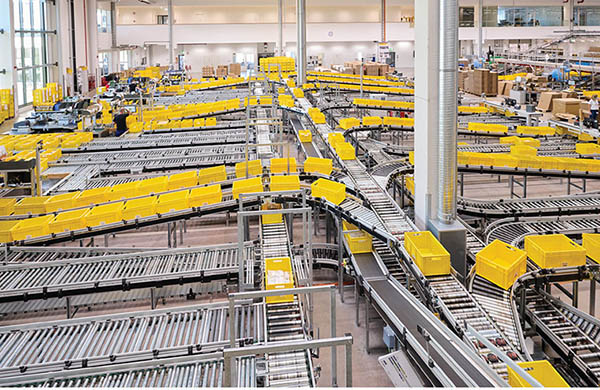
Going live
By November 2017, construction was far enough along to begin installing the 65-ft.-tall ASRS, with 11,000 pallet locations and 115,000 bin locations. In April 2018, the first bins began moving across conveyors and into storage. The building was complete, including connection to the HARTING IT network that June. While they continued to operate the old facility, product began to fill the new ASRS.
There were learning curves. One was how to operate a highly automated facility, requiring response times of less than 300 milliseconds, using SAP EWM.
“Our conveyor system can move 2,000 bins per hour,” Meyer said. “In the beginning, the systems weren’t well connected, and when a batch of orders would drop, the conveyor went down because the response time was too slow. It didn’t know where to move the bins.”
It took several months before all of the automation systems were stable and consistently functioning at a high performance level, said Meyer.
In March 2019, Meyer’s team began testing the order-fulfillment side of the building, processing a limited number of customer orders. About 6 months later, in September 2019, they began to shift more and more fulfillment from the old building into the new. “By March 2020, all of the systems from receiving to shipping were operating at higher than 99% capacity, and we were delivering everything from the new building,” Meyer says.
Along with automated storage, AGVs, and goods-to-person picking, the facility has at least two other unique features. One is the use of RFID already described. Another is the use of camera-based imaging in the picking and packing process.
“We have 30,000 different products,” Meyer said. “Every warehouse I visited that had pre-calculated box sizes had some kind of issue at packaging.”
HARTING takes a different approach. Overhead cameras take pictures of totes after the items for an order have been picked and are headed to packaging.
The photos serve two purposes: First, they serve as a record of a shipment in case a customer has a question after an order is received. “We have reduced our claims significantly,” Meyer said.
The second is to give packers an idea of what is coming their way so they can make the best box selection.
Since going live, the facility has received several design and architecture awards. More importantly, it positions HARTING for the future while also illustrating where warehouse automation may be headed.
“We are now flexible and fast to adapt to our customers’ requirements,” said Meyer. “Whatever a customer needs to optimize their inbound process we can do as a standard in our automation systems. That’s a key element and a competitive advantage for us.”
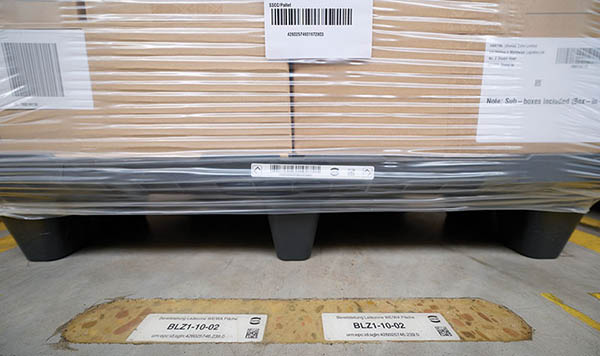
About the Author
Follow Robotics 24/7 on Linkedin
Article topics
Email Sign Up

